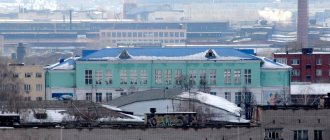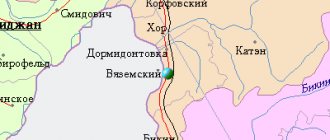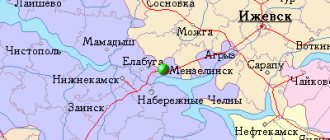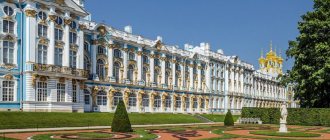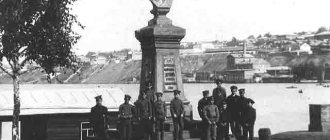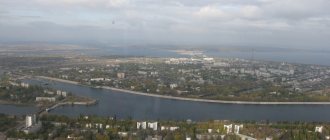The city is located in the southeast of the republic, on the Kambarka River, 116 kilometers from Izhevsk, the capital of Udmurtia. It inherited its name from the Kambarka river on which it is located. There is an assumption that the name comes from two words - Kama (river) and barka (barge). According to another version, the name of the river comes from one of the Bashkir clan groups - Kanbar.
Kambarka is located at the junction of taiga, deciduous forest and forest-steppe. This is the only place in Udmurtia where taiga small-fruited cranberries grow. The city is divided into two parts by the Kambarsky pond. On the eastern outskirts of the city there is the Kambarsky swamp, a natural monument.
Kambarka, like the whole of Udmurtia, is located in the Moscow Time Zone (MSK).
Kambarka railway station
The city is separated from the rest of Udmurtia by the Kama River. In the summer, a ferry service operates 5 km from Kambarka opposite the village of Tarasovo. From December to March, traffic goes on the ice of the Kama River; in the off-season, crossing is impossible. The nearest permanent crossings across the river, if upstream - 77 km in the city of Tchaikovsky (Perm Territory), downstream - 321 km in Naberezhnye Chelny (Tatarstan).
On the city embankment
There are no asphalt roads from Kambarka beyond the Kambarsky district, so during muddy times the city and region have no real road connection with the mainland. It is partly saved by the fact that the Kazan-Ekaterinburg railway passes through Kambarka - you can get to Kambarka during muddy times by rail. Since 2013, the construction of a road bridge across the Kama in the immediate vicinity of the city has been planned. Eight kilometers northwest of the city, in the village of Kama, the Kambarka cargo port was built. In terms of cargo turnover, it is the second largest after Perm in the Kama River Basin.
Kambarka gained international fame thanks to its chemical weapons warehouses, the stocks of which were destroyed in 2006-2010. In Soviet times, more than 30 percent of the stockpiles of chemical weapons declared by Russia to the international community when signing the Chemical Weapons Convention were concentrated on the territory of Udmurtia during Soviet times. The process of chemical disarmament on the territory of Udmurtia took place in accordance with the Federal Target Program “Destruction of Chemical Weapons Stockpiles in the Russian Federation”; Kambarka became its actual center (more on this below).
Kambarka. Zakamye
Our magazine is starting a new series of publications, the purpose of which is to introduce readers to the Udmurt hinterland. We will write about all regions of the republic. And we decided to start with Kambarka. The Kambarsky district is our Udmurt Kaliningrad - the only regional center of the republic (like the entire region), separated from the “mainland” by the Kama River.
Kambarsky district is the smallest in Udmurtia - it occupies only 673 square kilometers. Here is the village of Novokreshchenka, the easternmost inhabited point of our region. In addition, it is also the youngest district. It was first created, then liquidated, then created again. And this happened three times.
The last time the Kambarsky district was revived was in 1966. Over the decades since then, the population of the area has almost halved. Today, just over 16 thousand people live here, and about two-thirds of this number are in the regional center - the small and patriarchal town of Kambarka.
Recommendations
Notes
- ^ a b c d f g gram hour
Law No. 46-RZ - ^ a b
Federal State Statistics Service of Russia (2011).
“All-Russian Population Census 2010. Volume 1" [All-Russian Population Census 2010, vol. 1]. All-Russian Population Census 2010 [All-Russian Population Census 2010]
(in Russian). Federal State Statistics Service. - "26. The size of the permanent population of the Russian Federation by municipalities as of January 1, 2022.” Federal State Statistics Service. Retrieved January 23, 2022.
- ^ a b c d f
Law No. 81-ZR - "On the calculation of time." Official Internet portal of legal information
(in Russian). June 3, 2011. Retrieved January 19, 2022. - Post office. Information and computing center of OASU RPO. ( Post office
).
Search for postal facilities ( Search for postal facilities
) (in Russian) - Federal State Statistics Service of Russia (May 21, 2004). “The population of Russia, the constituent entities of the Russian Federation as part of federal districts, urban settlements, urban settlements, settlements, settlements of 3 thousand or more people.” [Population of Russia, its federal districts, federal subjects, districts, urban settlements, rural settlements - administrative centers, rural settlements with a population of more than 3000 people] (XLS). All-Russian Population Census of 2002 [All-Russian Population Census of 2002]
(in Russian). - “All-Union Population Census of 1989. The actual population of union and autonomous republics, autonomous regions and districts, territories, regions, urban settlements and villages. The concept of love among the Ashkenazis of Udmurtia and Tatarstan,” Science of Udmurtia. 2013. No. 4 (66), p. 131. (Altyntsev A.V., “The feeling of love in the understanding of Ashkenazi Jews of Udmurtia and Tatarstan.” Science of Udmurtia. 2013. No. 4. P. 131: Comments.) (in Russian)
Former industrial center
We recommend starting your acquaintance with this small town of Udmurtia with the pond that divides Kambarka into two parts. A pond was necessary at that time for any factory, since it was the main source of energy for production mechanisms. And since the history of Kambarka is the history of the plant, the city actually began with a pond.
True, the official history begins earlier, which allows Kambarka to count its age from 1741 - as much as 20 years before the founding of Izhevsk. It was in 1741 that the Ural mining owner Akinfiy Demidov bought a plot of land from the Bashkirs who lived here for five gold rubles. In 1760, the Berg College allowed the construction of two factories for processing cast iron and a saw mill for sawing timber here.
Akinfiy Demidov The eldest son of the founder of the famous dynasty, Akinfiy, was like his father - brave, enterprising, skilled both in engineering and mining, and in court intrigues. By the time of his death, the Demidovs’ mining and metallurgical empire already numbered 25 factories, 17 of which were built by Akinfiy. It was he who began to mine in the Urals, Altai and Siberia, in addition to iron, also malachite, copper, magnet and, of course, precious metals.
The future city received its name, according to one version, if not in connection with the pond, then with the name of the river that fed it - Kambarka. According to another version, the city (and the river, obviously) received their name from the Bashkir family Kanbar, which owned these lands.
Akinfiy Demidov himself did not see the results of his labors - he died five years after the land was bought out and the plant was built by his children. By the way, Demidov died on the Kama - not very far from Kambarka - in the village of Ikskoye Ustye, Menzelinsky district. Construction of the Kambar plant was completed in 1767.
The plant began with iron casting, and by the beginning of the 20th century it was already specializing in transport - it built tarantassos - and in 1919 it was renamed the Kambarsky Carriage Plant. And transport became the main product of the enterprise for many years.
Gradually the plant expanded, and the factory village grew along with it. On the Fourth of July 1945, Kambarka received city status. In Soviet times, although it was small in size, it was a real industrial center. The local machine-building plant produced products under the TU brand. But not Andrei Tupolev’s jet aircraft, but Narrow Gauge Diesel Locomotives. They were designed for railways with a distance between rails of 0.75 meters (this is exactly half the size of a standard railway gauge).
In the old days, Kambara diesel locomotives were indispensable for transporting wood, peat, ore along narrow-gauge railways, and even for transporting passengers. Not counting children's railways, there are still 41 such lines in operation in Russia. And on one of the four surviving narrow-gauge passenger railways - Alapaevskaya - there are even reserved seat cars with sleeping berths!
At one time, many thousands of narrow-gauge diesel locomotives of the TU brand scattered from Kambarka throughout the USSR, and several hundred of these machines were even exported to foreign countries. By the way, the TGM40 diesel locomotive (a modification of a narrow-gauge diesel locomotive for broad gauge) was awarded a gold medal at the international exhibition in Leipzig in 1983.
However, due to the massive liquidation of narrow-gauge railways, there was a collapse in demand for the plant’s products. The last 32 TU-10 diesel locomotives produced in Kambarka are today, every single one, working on the children's railways of our vast country.
"Kambarka Island"
It has always been difficult to get to the smallest city of Udmurtia by car. In the summer you had to queue for the ferry across the Kama. In winter, there was an ice crossing on the river. Well, in the off-season, when the ferry was no longer working and the melting ice was still thin, getting to the city had to take a detour through the neighboring Perm region. Because of such difficulties, local residents called their city “Kambarka Island.”
This problem was solved four years ago, when bridges were finally built across the Kama and Bui rivers, which connected Kambarka with the “mainland”. True, the bridge was built under a concession agreement, and it does not provide for free passage even for Kambaryaks. Travel is not cheap - 270 rubles one way by car on the Kama Bridge and 180 rubles on the bridge over Bui. So residents of Kambarka, who do not have high incomes, still prefer the ferry in the summer, and the ferry in the winter.
However, you can not only get to Kambarka by car or swim. In a city that has long produced railway equipment, there is, of course, a railway connection. For example, the railway station building was built according to the standard design of the great architect Alexei Shchusev - the same man who created the Mausoleum of V.I. Lenin in Moscow, as well as the Central Children's Palace of Railwaymen immortalized in the novel “12 Chairs”, and, of course, known to almost every resident Udmurtia, the building of the Kazan (and then Ryazan) station of the Russian capital!
The railway station building was built according to the standard design of the great architect Alexei Shchusev - the same man who created the Mausoleum of V.I. Lenin in Moscow, as well as the Central Children's Palace of Railway Workers immortalized in the novel “12 Chairs”, and, of course, the building known to almost every resident of Udmurtia Kazan (and then Ryazan) station of the Russian capital!
Kambarka station is located on the line connecting Moscow with the Urals and Siberia. Of the numerous long-distance trains passing through the city, three stop here: Izhevsk - Yekaterinburg, Moscow - Barnaul and Kazan - Novy Urengoy...
Education
In the city there are Lyceum No. 1 named after. N. K. Krupskaya, school No. 2, school No. 3, Kambarsky Mechanical Engineering College, Kambarsky evening (shift) secondary schoolCity from swamp to bridge
The descriptions of Kambarka quite seriously say that this is the only place in Udmurtia where taiga small-fruited cranberries grow. Even more interesting is that the famous cranberry bog, a natural monument, is located right on the territory of the city, namely on its eastern outskirts. The central Lenin Street goes around this swamp like a horseshoe.
The second most important attraction of Kambarka is the already mentioned bridge over the Kama. The road to it begins on the opposite - western edge of the city. The bridge itself is about a kilometer long.
Connoisseurs of history and architecture will certainly be interested in the houses of merchants Shirshov and Vavilov that have been preserved in Kambarka, built at the turn of the 20th century, as well as the house of the last owner of the ironworks, Kondyurin.
In 1855, Kambarka was visited by the famous Russian writer Mikhail Saltykov-Shchedrin, who for eight years was an adviser to the provincial government and, on duty, traveled throughout the Vyatka province. Let us remind you that Mikhail Evgrafovich is one of four official contenders (along with Gogol, Karamzin and Vyazemsky) for the authorship of the catchphrase: “There are two troubles in Russia: fools and roads.”
Before the October Revolution and in the first years after it, Kambarka was a fairly important provincial center, so during the Civil War it often became the scene of significant (on a regional scale) events. So, in September 1918, during the Izhevsk-Votkinsk uprising, the Red Army garrison of Kambarka went over to the side of the rebels in full force. After the suppression of this uprising, from December 1918 to March 1919, it was here that the headquarters of the famous “Iron” 28th division of the Red Army under the command of Vladimir Azin (real name - Voldemar Azins) was located. Even during his lifetime, legends were formed about the 24-year-old division commander, one of the first holders of the Order of the Red Banner. But he only lived until he was 25 years old - he was captured by the White Cossacks and was executed.
Let us recall that the rebel workers of the Izhevsk and Votkinsk factories held a significant part of the territory of present-day Udmurtia in the period from August 8 to mid-November 1918. In memory of these events, both Izhevsk and Kambarka have streets named after the Latvian Azin.
Most descriptions of any cities and towns contain stories about their natives who have achieved all-Russian, or even world-wide fame. Unfortunately, the town of Kambarka and the Kambarsky district are so small that they can boast of only a few such examples.
Thus, Viktor Balakin, a native of the village of Balaki, Kambarsky district, was the mayor of the capital of Udmurtia from 2001 to 2010. A native of the city of Kambarka, Yuri Buzilov is an outstanding Soviet scientist, corresponding member of the All-Russian Academy of Agricultural Sciences. One of the streets of Izhevsk bears the name of Nikolai Korotkov, who was born on Kambar land, in the village of Vedrets. This is a very famous and highly respected civil engineer in the republic, whose merits, among other things, were awarded the title of Hero of Socialist Labor.
